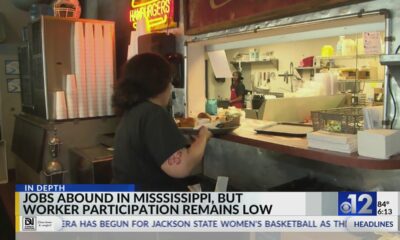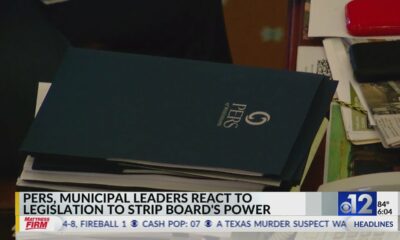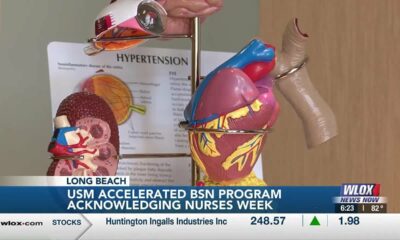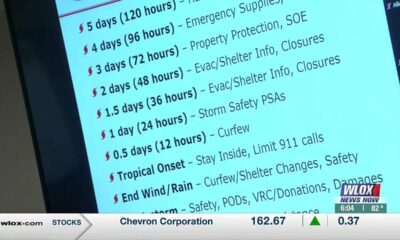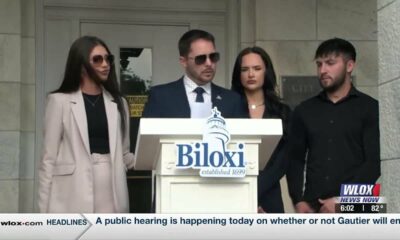Kaiser Health News
A Mom’s $97,000 Question: How Was Her Baby’s Air-Ambulance Ride Not Medically Necessary?
Molly Castle Work
Mon, 25 Mar 2024 09:00:00 +0000
Sara England was putting together Ghostbusters costumes for Halloween when she noticed her baby wasn't doing well.
Her 3-month-old son, Amari Vaca, had undergone open-heart surgery two months before, so she called his cardiologist, who recommended getting him checked out. England assigned Amari's grandparents to trick-or-treat duty with his three older siblings and headed to the local emergency room.
Once England and the baby arrived at Natividad Medical Center in Salinas, California, she said, doctors could see Amari was struggling to breathe and told her that he needed specialized care immediately, from whichever of two major hospitals in the region had an opening first.
Even as they talked, Amari was declining rapidly, his mother said. Doctors put a tube down his throat and used a bag to manually push air into his lungs for over an hour to keep his oxygen levels up until he was stable enough to switch to a ventilator.
According to England, late that night, when doctors said the baby was stable enough to travel, his medical team told her that a bed had opened up at the University of California-San Francisco Medical Center and that staffers there were ready to receive him.
She, her son, and an EMT boarded a small plane around midnight. Ground ambulances carried them between the hospitals and airports.
Amari was diagnosed with respiratory syncytial virus, or RSV, and spent three weeks in the hospital before recovering and returning home.
Then the bill came.
The Patient: Amari Vaca, now 1, who was covered by a Cigna policy sponsored by his father's employer at the time.
Medical Services: An 86-mile air-ambulance flight from Salinas to San Francisco.
Service Provider: Reach Medical Holdings, which is part of Global Medical Response, an industry giant backed by private equity investors. Global Medical Response operates in all 50 states and has said it has a total of 498 helicopters and airplanes. It is out-of-network with Amari's Cigna plan.
Total Bill: $97,599. Cigna declined to cover any part of the bill.
What Gives: Legal safeguards are in place to protect patients from big bills for some out-of-network care, including air-ambulance rides.
Medical billing experts said the No Surprises Act, a federal law enacted in 2022, could have protected Amari's family from receiving the $97,000 “balance bill,” leaving the insurer and the air-ambulance provider to determine fair payment according to the law. But the protections apply only to care that health plans determine is “medically necessary” — and insurers get to define what that means in each case.
According to its coverage denial letter, Cigna determined that Amari's air-ambulance ride was not medically necessary. The insurer cited its reasoning: He could have taken a ground ambulance instead of a plane to cover the nearly 100 roadway miles between Salinas and San Francisco.
“I thought there must have been a mistake,” England said. “There's no way we can pay this. Is this a real thing?”
In the letter, Cigna said Amari's records did not show that other methods of transportation were “medically contraindicated or not feasible.” The health plan also noted the absence of documentation that he could not be reached by a ground ambulance for pickup or that a ground ambulance would be unfeasible because of “great distances or other obstacles.”
Lastly, it said records did not show a ground ambulance “would impede timely and appropriate medical care.”
When KFF Health News asked Cigna what records were referenced when making this decision, a spokesperson declined to respond.
Caitlin Donovan, a spokesperson for the National Patient Advocate Foundation, said that even though Amari's bill isn't technically in violation of the No Surprises Act, the situation is exactly what the law was designed to avoid.
“What they're basically saying is that the parents should have opted against the advice of the physician,” Donovan said. “That's insane. I know ‘medical necessity' is this nebulous term, but it seems like it's becoming a catch-all for turning down patients.”
On Feb. 5, the National Association of Emergency Medical Services Physicians said that since the No Surprises Act was enacted two years ago, it has seen a jump in claim denials based on “lack of medical necessity,” predominantly for air-ambulance transports between facilities.
In a letter to federal health officials, the group cited reasons commonly given for inappropriate medical-necessity denials observed by some of its 2,000 members, such as “the patient should have been taken elsewhere” or “the patient could have been transported by ground ambulance.”
The association urged the government to require that health plans presume medical necessity for inter-facility air transports ordered by a physician at a hospital, subject to a retrospective review.
Such decisions are often “made under dire circumstances — when a hospital is not capable of caring for or stabilizing a particular patient or lacks the clinical resources to stabilize a patient with a certain clinical diagnosis,” the group's president, José Cabañas, wrote in the letter. “Clinical determinations made by a referring physician (or another qualified medical professional) should not be second-guessed by a plan.”
Patricia Kelmar, a health policy expert and senior director with the U.S. Public Interest Research Groups, noted, however, that hospitals could familiarize themselves with local health plans, for example, and establish protocol, so that before they call an air ambulance, they know if there are in-network alternatives and, if not, what items the plan needs to justify the claim and provide payment.
“The hospitals who live and breathe and work in our communities should be considering the individuals who come to them every day,” Kelmar said. “I understand in emergency situations you generally have a limited amount of time, but, in most situations, you should be familiar with the plans so you can work within the confines of the patient's health insurance.”
England said Cigna's denial particularly upset her.
“As parents, we did not make any of the decisions other than to say, yes, we'll do that,” she said. “I don't know how else it could have gone.”
The Resolution: England twice appealed the air-ambulance charge to the insurer, but both times Cigna rejected the claim, maintaining that “medical necessity” had not been established.
The final step of the appeals process is an external review, in which a third party evaluates the case. England said staff members at Natividad Medical Center in Salinas — which arranged Amari's transport — declined to write an appeal letter on his behalf, explaining to her that doing so is against the facility's policy.
Using her son's medical records, which the Natividad staff provided, England said she is writing a letter herself to assert why the air ambulance was medically necessary.
Andrea Rosenberg, a spokesperson for Natividad Medical Center, said the hospital focuses on “maintaining the highest standards of health care and patient well-being.”
Despite receiving a waiver from England authorizing the medical center to discuss Amari's case, Rosenberg did not respond to questions from KFF Health News, citing privacy issues. A Cigna spokesperson told KFF Health News that the insurer has in-network alternatives to the out-of-network ambulance provider, but — despite receiving a waiver authorizing Cigna to discuss Amari's case — declined to answer other questions.
“It is disappointing that CALSTAR/REACH is attempting to collect this egregious balance from the patient's family,” the Cigna spokesperson, Justine Sessions, said in an email, referring to the air-ambulance provider. “We are working diligently to try to resolve this for the family.”
On March 13, weeks after being contacted by KFF Health News, England said, a Cigna representative contacted her and offered assistance with her final appeal, the one reviewed by a third party. The representative also told her the insurer had attempted to contact the ambulance provider but had been unable to resolve the bill with them.
Global Medical Response, the ambulance provider, declined to comment.
England said she and her husband have set aside two hours each week for him to take care of their four kids while she shuts herself in her room and makes calls about their medical bills.
“It's just another stress,” she said. “Another thing to get in the way of us being able to enjoy our family.”
The Takeaway: Kelmar said she encourages patients to appeal bills that seem inaccurate. Even if the plan denies it internally, push forward to an external review so someone outside the company has a chance to review, she said.
In the case of “medical necessity” denials, Kelmar recommended patients work with the medical provider to provide more information to the insurance company to underscore why an emergency transport was required.
More from Bill of the Month
-
Without Medicare Part B's Shield, Patient's Family Owes $81,000 for a Single Air-Ambulance Flight
Feb 27, 2024
-
The Colonoscopies Were Free. But the ‘Surgical Trays' Came With $600 Price Tags.
Jan 25, 2024
-
When a Quick Telehealth Visit Yields Multiple Surprises Beyond a Big Bill
Dec 19, 2023
Doctors who write a letter or make a call to a patient's insurer explaining a decision can also ask for a “peer-to-peer review,” meaning they would discuss the case with a medical expert in their field.
Kelmar said patients with employer-sponsored health plans can ask their employer's human resources department to advocate for them with the health plan. It's in the employers' best interest since they often pay a lot for these health plans, she said.
No matter what, Kelmar said, patients shouldn't let fear stop them from appealing a medical bill. Patients who appeal have a high likelihood of winning, she said.
Patients with government health coverage can further appeal insurance denials by filing a complaint with the Centers for Medicare & Medicaid Services. Those who believe they have received an inappropriate bill from an out-of-network provider can call the No Surprises Act help desk at 1-800-985-3059.
Bill of the Month is a crowdsourced investigation by KFF Health News and NPR that dissects and explains medical bills. Do you have an interesting medical bill you want to share with us? Tell us about it!
This article was produced by KFF Health News, which publishes California Healthline, an editorially independent service of the California Health Care Foundation.
KFF Health News is a national newsroom that produces in-depth journalism about health issues and is one of the core operating programs at KFF—an independent source of health policy research, polling, and journalism. Learn more about KFF.
USE OUR CONTENT
This story can be republished for free (details).
——————————
By: Molly Castle Work
Title: A Mom's $97,000 Question: How Was Her Baby's Air-Ambulance Ride Not Medically Necessary?
Sourced From: kffhealthnews.org/news/article/medical-necessity-rsv-infant-air-ambulance-surprise-bill/
Published Date: Mon, 25 Mar 2024 09:00:00 +0000
Did you miss our previous article…
https://www.biloxinewsevents.com/after-appalachian-hospitals-merged-into-a-monopoly-their-ers-slowed-to-a-crawl/
Kaiser Health News
Amgen Plows Ahead With Costly, Highly Toxic Cancer Dosing Despite FDA Challenge
Arthur Allen
Tue, 07 May 2024 09:00:00 +0000
When doctors began using the drug sotorasib in 2021 with high expectations for its innovative approach to attacking lung cancer, retired medical technician Don Crosslin was an early beneficiary. Crosslin started the drug that July. His tumors shrank, then stabilized.
But while the drug has helped keep him alive, its side effects have gradually narrowed the confines of his life, said Crosslin, 76, who lives in Ocala, Florida: “My appetite has been minimal. I'm very weak. I walk my dogs and get around a bit, but I haven't been able to golf since last July.”
He wonders whether he'd do better on a lower dose, “but I do what my oncologist tells me to do,” Crosslin said. Every day, he takes eight of the 120-milligram pills, sold under Amgen's brand name Lumakras.
Crosslin's concern lies at the heart of an FDA effort to make cancer drugs less toxic and more effective. Cancer drug trials are structured to promote high doses, which then become routine patient care. In the face of evidence that thousands of patients become so ill that they skip doses or stop taking the drugs — thereby risking resurgence of their cancers — the FDA has begun requiring companies to pinpoint the right dosage before they reach patients.
The initiative, Project Optimus, launched in 2021 just as Amgen was seeking to market sotorasib. At the time, the FDA's leading cancer drug regulator, Richard Pazdur, co-authored an editorial in the New England Journal of Medicine that said Amgen's trials of the $20,000-a-month drug were “hampered by a lack of robust dose exploration.”
The FDA conditionally approved sotorasib but required Amgen to conduct a study comparing the labeled dosage of 960 mg with a dosage of 240 mg. The trial, published in November, showed that the 960-mg dose may have given patients a month more of life, on average, but caused more severe side effects than the lower dose.
Amgen is keeping the 960-mg dosage as it conducts further tests to get final approval for the drug, spokesperson Elissa Snook said, adding that the dose showed superiority in one study. Whether medically justified or not, the heavier dosage allows the company to protect 75% of its revenue from the drug, which brought in nearly $200 million in the United States last year.
And there appears to be nothing the FDA can do about it.
“There's a gap in FDA's authority that results in patients getting excess doses of a drug at excess costs,” said Mark Ratain, a University of Chicago oncologist who has pushed for more accurate cancer drug dosing. “We should do something about this.”
Deciding on Dosage
It may be too late for the FDA to change the sotorasib dosage, although in principle it could demand a new regimen before granting final approval, perhaps in 2028. Under Project Optimus, however, the agency is doing something about dosage guidelines for future drugs. It is stressing dose optimization in its meetings with companies, particularly as they prepare to test drugs on patients for the first time, spokesperson Lauren-Jei McCarthy said.
“When you go in front of FDA with a plan to approve your drug now, they are going to address dosing studies,” said Julie Gralow, chief medical officer of the American Society of Clinical Oncology. “A lot of companies are struggling with this.”
That's largely because the new requirements add six months to a year and millions in drug development costs, said Julie Bullock, a former FDA drug reviewer who advocated for more extensive dosing studies and is now senior vice president at Certara, a drug development consultancy.
In part, Project Optimus represents an effort to manage the faults of the FDA's accelerated approval process, begun in 1992. While the process gets innovative drugs to patients more quickly, some medicines have proved lackluster or had unacceptable side effects.
That's especially true of the newer pills to treat cancer, said Donald Harvey, an Emory University pharmacology professor, who has led or contributed to more than 100 early-phase cancer trials.
A study released last month in the Journal of the American Medical Association showed that 41% of the cancer drugs granted accelerated approval from 2013 to 2017 did not improve overall survival or quality of life after five years.
Many of these drugs flop because they must be given at toxic dosages to have any effect, Harvey said, adding that sotorasib might work better if the company had found an appropriate dosage earlier on.
“Sotorasib is a poster child for incredibly bad development,” Harvey said. The drug was the first to target the KRAS G12C mutation, which drives about 15% of lung cancers and was considered “undruggable” until University of California-San Francisco chemist Kevan Shokat figured out how to attack it in 2012.
Given the specificity of sotorasib's target, Harvey said, Amgen could have found a lower dosage. “Instead, they followed the old model and said, ‘We're going to push the dose up until we see a major side effect.' They didn't need to do that. They just needed more experience with a lower dose.”
The 960-mg dose “is really tough on patients,” said Yale University oncologist and assistant professor Michael Grant. “They get a lot of nausea and other GI side effects that are not pleasant. It hurts their quality of life.”
The FDA noted in its review of sotorasib that in phase 1 studies tumors shrank when exposed to as little as a fifth of the 960-mg daily dose Amgen selected. At all doses tested in that early trial, the drug reached roughly the same concentrations in the blood, which suggested that at higher doses the drug was mostly just intensifying side effects like diarrhea, vomiting, and mouth sores.
For most classes of drugs, companies spend considerable time in phases 1 and 2 of development, homing in on the right dosage. “No one would think of dosing a statin or antibiotic at the highest tolerable dose,” Ratain said.
Things are different in cancer drug creation, whose approach originated with chemotherapy, which damages as many cancer cells as possible, wrecking plenty of healthy tissue in the bargain. Typically, a company's first series of cancer drug trials involve escalating doses in small groups of patients until something like a quarter of them get seriously ill. That “maximum tolerated dose” is then employed in more advanced clinical trials, and goes on the drug's label. Once a drug is approved, a doctor can “go off-label” and alter the dosage, but most are leery of doing so.
Patients can find the experience rougher than advertised. During clinical trials, the side effects of the cancer drug osimertinib (Tagrisso) were listed as tolerable and manageable, said Jill Feldman, a lung cancer patient and advocate. “That killed me. After two months on that drug, I had lost 15 pounds, had sores in my mouth and down my throat, stomach stuff. It was horrible.”
Some practitioners, at least, have responded to the FDA's cues on sotorasib. In the Kaiser Permanente health system, lung cancer specialists start with a lower dose of the drug, spokesperson Stephen Shivinsky said.
Smaller Doses — And Revenue
Amgen was clearly aware of the advantages of the 240-mg dosage before it sought FDA approval: It filed a provisional patent application on that dosage before the agency gave breakthrough approval for the drug at 960 mg. The company doesn't appear to have disclosed the patent filing to investors or the FDA. McCarthy said the FDA was prohibited by law from discussing the particulars of its sotorasib regulation plans.
Switching to a 240-mg dosage could register a huge hit to Amgen's revenue. The company markets the drug at more than $20,000 for a month of 960-mg daily doses. Each patient who could get by with a quarter of that would trim the company's revenue by roughly $180,000 a year.
Amgen declined to comment on the patent issue or to make an official available to discuss the dosage and pricing issues.
Crosslin, who depends on Social Security for his income, couldn't afford the $3,000 a month that Medicare required him to pay for sotorasib, but he has received assistance from Amgen and a charity that covers costs for patients below a certain income.
While the drug has worked well for Crosslin and other patients, its overall modest impact on lung cancer suggests that $5,000, rather than $20,000, might be a more appropriate price, Ratain said.
In the company's phase 3 clinical trial for advanced lung cancer patients, sotorasib kept patients alive for about a month longer than docetaxel, the current, highly toxic standard of care. Docetaxel is a generic drug for which Medicare pays about $1 per injection. The trial was so unconvincing that the FDA sent Amgen back to do another.
Ratain, a staunch critic of Amgen's handling of sotorasib, told Centers for Medicare & Medicaid Services officials at a recent meeting that they should pay for sotorasib on a basis of 240 mg per day. But CMS would do that only “if there is a change in the drug's FDA-approved dosage,” spokesperson Aaron Smith said.
Drug companies generally don't want to spend money on trials like the one the FDA ordered on sotorasib. In 2018, Ratain and other researchers used their institutions' funding to conduct a dosing trial on the prostate cancer drug abiraterone, marketed under the brand name Zytiga by Johnson & Johnson. They found that taking one 250-mg pill with food was just as effective as taking four on an empty stomach, as the label called for.
Although J&J hasn't changed the Zytiga label, the evidence generated in that trial was strong enough for the standards-setting National Comprehensive Cancer Network to change its recommendations.
Post-marketing studies like that one are hard to conduct, Emory's Harvey said. Patients are reluctant to join a trial in which they may have to take a lower dosage, since most people tend to believe “the more the better,” he said.
“It's better for everyone to find the right dose before a drug is out on the market,” Harvey said. “Better for the patient, and better for the company, which can sell more of a good drug if the patients aren't getting sick and no longer taking it.”
——————————
By: Arthur Allen
Title: Amgen Plows Ahead With Costly, Highly Toxic Cancer Dosing Despite FDA Challenge
Sourced From: kffhealthnews.org/news/article/amgen-cancer-drug-sotorasib-lumakras-high-dosage-fda-dosing-trials/
Published Date: Tue, 07 May 2024 09:00:00 +0000
Kaiser Health News
What’s Keeping the US From Allowing Better Sunscreens?
Michael Scaturro
Tue, 07 May 2024 09:00:00 +0000
When dermatologist Adewole “Ade” Adamson sees people spritzing sunscreen as if it's cologne at the pool where he lives in Austin, Texas, he wants to intervene. “My wife says I shouldn't,” he said, “even though most people rarely use enough sunscreen.”
At issue is not just whether people are using enough sunscreen, but what ingredients are in it.
The Food and Drug Administration's ability to approve the chemical filters in sunscreens that are sold in countries such as Japan, South Korea, and France is hamstrung by a 1938 U.S. law that requires sunscreens to be tested on animals and classified as drugs, rather than as cosmetics as they are in much of the world. So Americans are not likely to get those better sunscreens — which block the ultraviolet rays that can cause skin cancer and lead to wrinkles — in time for this summer, or even the next.
Sunscreen makers say that requirement is unfair because companies including BASF Corp. and L'Oréal, which make the newer sunscreen chemicals, submitted safety data on sunscreen chemicals to the European Union authorities some 20 years ago.
Steven Goldberg, a retired vice president of BASF, said companies are wary of the FDA process because of the cost and their fear that additional animal testing could ignite a consumer backlash in the European Union, which bans animal testing of cosmetics, including sunscreen. The companies are asking Congress to change the testing requirements before they take steps to enter the U.S. marketplace.
In a rare example of bipartisanship last summer, Sen. Mike Lee (R-Utah) thanked Rep. Alexandria Ocasio-Cortez (D-N.Y.) for urging the FDA to speed up approvals of new, more effective sunscreen ingredients. Now a bipartisan bill is pending in the House that would require the FDA to allow non-animal testing.
“It goes back to sunscreens being classified as over-the-counter drugs,” said Carl D'Ruiz, a senior manager at DSM-Firmenich, a Switzerland-based maker of sunscreen chemicals. “It's really about giving the U.S. consumer something that the rest of the world has. People aren't dying from using sunscreen. They're dying from melanoma.”
Every hour, at least two people die of skin cancer in the United States. Skin cancer is the most common cancer in America, and 6.1 million adults are treated each year for basal cell and squamous cell carcinomas, according to the Centers for Disease Control and Prevention. The nation's second-most-common cancer, breast cancer, is diagnosed about 300,000 times annually, though it is far more deadly.
Dermatologists Offer Tips on Keeping Skin Safe and Healthy
– Stay in the shade during peak sunlight hours, 10 a.m. to 4 p.m. daylight time.– Wear hats and sunglasses.– Use UV-blocking sun umbrellas and clothing.– Reapply sunscreen every two hours.You can order overseas versions of sunscreens from online pharmacies such as Cocooncenter in France. Keep in mind that the same brands may have different ingredients if sold in U.S. stores. But importing your sunscreen may not be affordable or practical. “The best sunscreen is the one that you will use over and over again,” said Jane Yoo, a New York City dermatologist.
Though skin cancer treatment success rates are excellent, 1 in 5 Americans will develop skin cancer by age 70. The disease costs the health care system $8.9 billion a year, according to CDC researchers. One study found that the annual cost of treating skin cancer in the United States more than doubled from 2002 to 2011, while the average annual cost for all other cancers increased by just 25%. And unlike many other cancers, most forms of skin cancer can largely be prevented — by using sunscreens and taking other precautions.
But a heavy dose of misinformation has permeated the sunscreen debate, and some people question the safety of sunscreens sold in the United States, which they deride as “chemical” sunscreens. These sunscreen opponents prefer “physical” or “mineral” sunscreens, such as zinc oxide, even though all sunscreen ingredients are chemicals.
“It's an artificial categorization,” said E. Dennis Bashaw, a retired FDA official who ran the agency's clinical pharmacology division that studies sunscreens.
Still, such concerns were partly fed by the FDA itself after it published a study that said some sunscreen ingredients had been found in trace amounts in human bloodstreams. When the FDA said in 2019, and then again two years later, that older sunscreen ingredients needed to be studied more to see if they were safe, sunscreen opponents saw an opening, said Nadim Shaath, president of Alpha Research & Development, which imports chemicals used in cosmetics.
“That's why we have extreme groups and people who aren't well informed thinking that something penetrating the skin is the end of the world,” Shaath said. “Anything you put on your skin or eat is absorbed.”
Adamson, the Austin dermatologist, said some sunscreen ingredients have been used for 30 years without any population-level evidence that they have harmed anyone. “The issue for me isn't the safety of the sunscreens we have,” he said. “It's that some of the chemical sunscreens aren't as broad spectrum as they could be, meaning they do not block UVA as well. This could be alleviated by the FDA allowing new ingredients.”
Ultraviolet radiation falls between X-rays and visible light on the electromagnetic spectrum. Most of the UV rays that people come in contact with are UVA rays that can penetrate the middle layer of the skin and that cause up to 90% of skin aging, along with a smaller amount of UVB rays that are responsible for sunburns.
The sun protection factor, or SPF, rating on American sunscreen bottles denotes only a sunscreen's ability to block UVB rays. Although American sunscreens labeled “broad spectrum” should, in theory, block UVA light, some studies have shown they fail to meet the European Union's higher UVA-blocking standards.
“It looks like a number of these newer chemicals have a better safety profile in addition to better UVA protection,” said David Andrews, deputy director of Environmental Working Group, a nonprofit that researches the ingredients in consumer products. “We have asked the FDA to consider allowing market access.”
The FDA defends its review process and its call for tests of the sunscreens sold in American stores as a way to ensure the safety of products that many people use daily, rather than just a few times a year at the beach.
“Many Americans today rely on sunscreens as a key part of their skin cancer prevention strategy, which makes satisfactory evidence of both safety and effectiveness of these products critical for public health,” Cherie Duvall-Jones, an FDA spokesperson, wrote in an email.
D'Ruiz's company, DSM-Firmenich, is the only one currently seeking to have a new over-the-counter sunscreen ingredient approved in the United States. The company has spent the past 20 years trying to gain approval for bemotrizinol, a process D'Ruiz said has cost $18 million and has advanced fitfully, despite attempts by Congress in 2014 and 2020 to speed along applications for new UV filters.
Bemotrizinol is the bedrock ingredient in nearly all European and Asian sunscreens, including those by the South Korean brand Beauty of Joseon and Bioré, a Japanese brand.
D'Ruiz said bemotrizinol could secure FDA approval by the end of 2025. If it does, he said, bemotrizinol would be the most vetted and safest sunscreen ingredient on the market, outperforming even the safety profiles of zinc oxide and titanium dioxide.
As Congress and the FDA debate, many Americans have taken to importing their own sunscreens from Asia or Europe, despite the risk of fake products.
“The sunscreen issue has gotten people to see that you can be unsafe if you're too slow,” said Alex Tabarrok, a professor of economics at George Mason University. “The FDA is just incredibly slow. They've been looking at this now literally for 40 years. Congress has ordered them to do it, and they still haven't done it.”
——————————
By: Michael Scaturro
Title: What's Keeping the US From Allowing Better Sunscreens?
Sourced From: kffhealthnews.org/news/article/better-sunscreen-ingredients-animal-testing-us-vs-other-countries-regulations-cancer-risk/
Published Date: Tue, 07 May 2024 09:00:00 +0000
Did you miss our previous article…
https://www.biloxinewsevents.com/biden-teams-tightrope-reining-in-rogue-obamacare-agents-without-slowing-enrollment/
Kaiser Health News
Biden Team’s Tightrope: Reining In Rogue Obamacare Agents Without Slowing Enrollment
Julie Appleby, KFF Health News
Tue, 07 May 2024 09:00:00 +0000
President Joe Biden counts among his accomplishments the record-high number of people, more than 21 million, who enrolled in Obamacare plans this year. Behind the scenes, however, federal regulators are contending with a problem that affects people's coverage: rogue brokers who have signed people up for Affordable Care Act plans, or switched them into new ones, without their permission.
Fighting the problem presents tension for the administration: how to thwart the bad actors without affecting ACA sign-ups.
Complaints about these unauthorized changes — which can cause affected policyholders to lose access to medical care, pay higher deductibles, or even incur surprise tax bills — rose sharply in recent months, according to brokers who contacted KFF Health News and federal workers who asked not to be identified.
Ronnell Nolan, president and CEO of the trade association Health Agents for America, said her group has suggested to the Centers for Medicare & Medicaid Services that it add two-factor authentication to healthcare.gov or send text alerts to consumers if an agent tries to access their accounts. But the agency told her it doesn't always have up-to-date contact information.
“We've given them a whole host of ideas,” she said. “They say, ‘Be careful what you wish for.' But we don't mind going an extra step if you can stop this fraud and abuse, because clients are being hurt.”
Some consumers are pursued when they respond to misleading social media marketing ads promising government subsidies, but most have no idea how they fell victim to plan-switching. Problems seem concentrated in the 32 states using the federal exchange.
Federal regulators have declined to say how many complaints about unauthorized sign-ups or plan switches they've received, or how many insurance agents they've sanctioned as a result. But the problem is big enough that CMS says it's working on technological and regulatory solutions. Affected consumers and agents have filed a civil lawsuit in federal district court in Florida against private-sector firms allegedly involved in unauthorized switching schemes.
Biden has pushed hard to make permanent the enhanced subsidies first put in place during the covid pandemic that, along with other steps including increased federal funding for outreach, helped fuel the strong enrollment growth. Biden contrasts his support for the ACA with the stance of former President Donald Trump, who supported attempts to repeal most of the law and presided over funding cuts and declining enrollment.
Most proposed solutions to the rogue-agent problem involve making it more difficult for agents to access policyholder information or requiring wider use of identity questions tied to enrollees' credit history. The latter could be stumbling blocks for low-income people or those with limited financial records, said Sabrina Corlette, co-director of the Center on Health Insurance Reforms at Georgetown University.
“That is the knife edge the administration has to walk,” said Corlette, “protecting consumers from fraudulent behavior while at the same time making sure there aren't too many barriers.”
Jeff Wu, acting director of the Center for Consumer Information & Insurance Oversight, said in a statement that the agency is evaluating options on such factors as how effective they would be, their impact on consumers' ability to enroll, and how fast they could be implemented.
The agency is also working closely, he wrote, with insurance companies, state insurance departments, and law enforcement “so that agents violating CMS rules or committing fraud face consequences.” And it is reaching out to states that run their own ACA markets for ideas.
That's because Washington, D.C., and the 18 states that run their own ACA marketplaces have reported far fewer complaints about unauthorized enrollment and plan-switching. Most include layers of security in addition to those the federal marketplace has in place — some use two-factor authentication — before agents can access policyholder information.
California, for example, allows consumers to designate an agent and to “log in and add or remove an agent at will,” said Robert Kingston, interim director of outreach and sales for Covered California, the state's ACA marketplace. The state can also send consumers a one-time passcode to share with an agent of their choice. Consumers in Colorado and Pennsylvania can similarly designate specific agents to access their accounts.
By contrast, agents can more easily access policyholder information when using private-sector websites that link them to the federal ACA market — all they need is a person's name, date of birth, and state of residence — to enroll them or switch their coverage.
CMS has approved dozens of such “enhanced direct enrollment” websites run by private companies, which are designed to make it easier and faster for agents certified to offer insurance through healthcare.gov.
Rules went into effect last June requiring agents to get written or recorded consent from clients before enrolling them or changing their coverage, but brokers say they're rarely asked to produce the documentation. If CMS makes changes to healthcare.gov — such as adding passcodes, as California has — it would need to require all alternative-enrollment partners to do the same.
The largest is San Francisco-based HealthSherpa, which assisted 52% of active enrollments nationally for this year, said CEO George Kalogeropoulos.
The company has a 10-person fraud investigation team, he said, which has seen “a significant spike in concerns about unauthorized switching.” They report problems to state insurance departments, insurance carriers, and federal regulators “and refer consumers to advocates on our team to make sure their plans are corrected.”
Solutions must be “targeted,” he said. “The issue with some of the solutions proposed is it negatively impacts the ability of all consumers to get enrolled.”
Most people who sign up for ACA plans are aided by agents or platforms like HealthSherpa, rather than doing it themselves or seeking help from nonprofit organizations. Brokers don't charge consumers; instead, they receive commissions from insurers participating in state and federal marketplaces for each person they enroll in a plan.
While California officials say their additional layers of authentication have not noticeably affected enrollment numbers, the state's recent enrollment growth has been slower than in states served by healthcare.gov.
Still, Covered California's Kingston pointed to a decreased number of uninsured people in the state. In 2014, when much of the ACA was implemented, 12.5% of Californians were uninsured, falling to 6.5% in 2022, according to data compiled by KFF. That year, the share of people uninsured nationwide was 8%.
Corlette said insurers have a role to play, as do states and CMS.
“Are there algorithms that can say, ‘This is a broker with outlier behavior'?” Insurance companies could then withhold commissions “until they can figure it out,” she said.
Kelley Schultz, vice president of commercial policy at AHIP, the trade association for large insurance companies, said sharing more information from the government marketplace about which policies are being switched could help insurers spot patterns.
CMS could also set limits on plan switches, as there is generally no legitimate need for multiple changes in a given month, Schultz said.
——————————
By: Julie Appleby, KFF Health News
Title: Biden Team's Tightrope: Reining In Rogue Obamacare Agents Without Slowing Enrollment
Sourced From: kffhealthnews.org/news/article/obamacare-enrollment-plan-switching-rogue-agents-enforcement/
Published Date: Tue, 07 May 2024 09:00:00 +0000
-
SuperTalk FM5 days ago
Driver’s education set to become mandatory in Mississippi as bill passes
-
SuperTalk FM4 days ago
State approves $160M to expand Highway 7 to four lanes in Lafayette County
-
SuperTalk FM1 day ago
Legislation outlawing ‘squatted’ vehicles in Mississippi signed into law
-
Mississippi Business7 days ago
Geartek expanding operations in Alcorn County
-
Mississippi News2 days ago
LCSO wants people aware of a scam circling the area
-
Mississippi Today3 days ago
On this day in 1917
-
Mississippi News6 days ago
Altercation at Mississippi police department leads to officer-involved shooting
-
Mississippi News2 days ago
Winston Co. Sheriff’s Office investigates shooting at Dave’s Club







